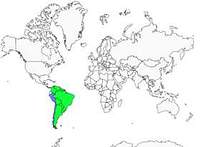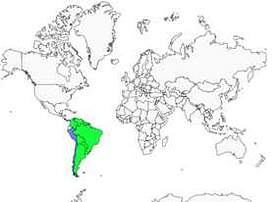Maguari Stork
Ciconia maguari - Cigogne maguari
Identification
The Maguari Stork is a South American wading bird of the genus Ciconia. It takes its species name from a locality in Brazil, where the first specimen was described.
Its general look and colors resemble the White Stork, and its measurements are comparable. As with the White Stork, the Maguari Stork when perched appears white with black at the back and on the back. The black refers to the wings and tail.
The wing black, in addition to the remiges, alula, greater coverts, primary coverts and scapulars.
The short, fork-tailed black tail is shorter than the rigid, extended white undertails, which mimic rectrices. The tail is less noticeable on a perched bird.
Seen from below, the bird flying appears white and black like the White Stork. What distinguishes it from the latter is the darker undersides of the wings and the original design of the tail region.
The bill, longer and stronger than that of the White Stork, is a different color, light bluish gray at the base, dark red in its distal half.
The eyes are pale yellow, surrounded by a red, grainy bare skin area extending to the lores. The bare gular area is also red.
The legs and toes are red.
As with other storks, there is no sexual dimorphism.
Juveniles resemble adults, but the bare head skin is black the first year. The legs and bill are duller, the middle and small coverts are more or less specked with black. The eyes are brown and only become pale yellow late. This is the best criterion for distinguishing young from adults.
Subspecific information monotypic species
Foreign names
- Cigogne maguari,
- Cigüeña maguari,
- maguari,
- Maguaristorch,
- maguari gólya,
- Magoeari,
- Cicogna maguari,
- maguaristork,
- Maguaristork,
- bocian maguari,
- čáp jihoamerický,
- Maguaristork,
- amerikankattohaikara,
- cigonya sud-americana,
- bocian sinodzioby,
- Американский аист,
- シロエンビコウ,
- 黑尾鹳,
- maguaristork,
- 黑尾鸛,
Voice song and call
The Maguari Stork, usually silent, emits a two-note whistle during displays, which is slower and less shrill than the ones emitted by other storks. It may also snap its beak during confrontations between males, or when its nest is disturbed.
The chicks' begging call is a raspy "ehehe-ehehe".
Habitat
Behaviour character trait
The Maguari Stork is a rather solitary species outside of the breeding period. However, it can hunt in either mono- or multi-specific groups.
It hunts by sight, slowly walking through shallow water with its neck stretched out and its beak open near the surface. It sometimes scratches the bottom of the water or probes the mud. It strikes its prey multiple times or pins it with its beak before swallowing it.
When the environment dries up and prey becomes scarce, Maguari Storks will practice kleptoparasitism among themselves as has been shown in the Llanos of Venezuela. Jabirus can also steal their prey from them.
Flight
Dietfeeding habits
The diet of the Maguari Stork is very varied compared to that of the sympatric Ciconiidae, the Jabiru and the American Tantale. A study conducted in the Llanos of Venezuela on 344 prey showed that the main diet consists of small vertebrates, fish (44%), frogs (32%), small rodents (12%). The diet of young in the nest varies according to prey availability.
Reproduction nesting
If the Maguari Stork nests in bushes or shrubs less than 6 m high to the north of its range, for example in the Llanos of Venezuela, elsewhere, in Brazil and Argentina, it mainly nests on the ground in marshlands.
Couples can nest isolatedly or they can get together with other birds to form small, loose colonies of 5 to 15 nests, mixing with other species when necessary. In Venezuela a study showed that colonial reproduction accounted for 77% of the couples and that reproductive success was higher there.
From one year to the next, the couples return to the same zone, sometimes on the same site.
The couple generally builds a new nest, the old one rarely being reusable. The nests built in trees can measure 2 m in diameter and 75 cm thick, they are made of branches and then lined with moist grass, which hardens as it dries. On the ground, the nests are usually made of reeds, then covered with grass and aquatic plants. Built on the bottom of the marshes, they measure up to 2.50 m in diameter and one meter in height and are 50 cm higher than the water level.
Mating takes place on the nest. The female lays 2 to 4 eggs, 2 to 3 days apart. They are incubated from the time the second one is laid. Incubation lasts 29 to 32 days, alternately taken care of by the two parents.
At first covered with a sparse white down, the chick then gets a very dark, almost black down, which it will keep until the juvenile plumage grows.This dark plumage sometimes mixed with a hint of white down is unique among storks. It would help to camouflage the nests. The young are never left unattended until they are 6 weeks old. They leave the nest after about two months, then weighing in at 4 kg, a bit more than their parents. They form groups with other young from the colony, continue to be fed by their parents, and return to the nest at night for another 6 weeks. Sexual maturity is reached at 3 years old for males and 4 years old for females.
Geographic range
The Maguari Stork is a South American species. Its range is divided into two parts. In the north, it can be found from the center of Colombia to the northernmost part of Brazil. It is occasional in French Guiana and Surinam. The second, larger subset ranges from the center of Brazil to the center of Argentina, including eastern Bolivia, Uruguay, and Paraguay. To the west of the Andes, in Chile, it is rare and probably non-breeding. It is a partially migratory species, with its movements not well understood. In the north, the birds leave the Llanos when the wetlands dry out. The same phenomenon can be observed in Bolivia and in the north of Argentina. The presence of Maguari Storks in the south of its range and in Chile is probably due to the same climatic cause.
Threats - protection
IUCN conservation status
concern
in the Wild
threatened
evaluated
The Maguari Stork is not considered threatened as a whole since its range is very wide. According to the IUCN, the population is stable. However, a study conducted at the end of the last century in the Llanos of Venezuela had already shown a distinct regression of the species. The main threat seems to be related to the loss of its habitat and the development of agriculture leading to an intensive use of pesticides.
Sources of information
- IOC World Bird List (v15.1), Gill, F and D Donsker (Eds). 2025-12-07.
- Storks; ibises and spoonbills, James Hancock, James Kushlan et Philip Kahl
- Birds of Venezuela, Steven L. Hilty
- Wikipedia (English version),
- HBW Alive,
- IUCN Red List of Threatened species,
Other sources of interest
 Specification sheet created on
30/07/2023 by Catherine et Bernard Lanneluc
Specification sheet created on
30/07/2023 by Catherine et Bernard LannelucTranslation by AI Oiseaux.net
© 1996-2025 Oiseaux.net
- Accipitriformes
- Aegotheliformes
- Anseriformes
- Apodiformes
- Apterygiformes
- Bucerotiformes
- Caprimulgiformes
- Cariamiformes
- Casuariiformes
- Charadriiformes
- Ciconiiformes
- Coliiformes
- Columbiformes
- Coraciiformes
- Cuculiformes
- Eurypygiformes
- Falconiformes
- Galliformes
- Gaviiformes
- Gruiformes
- Leptosomiformes
- Mesitornithiformes
- Musophagiformes
- Nyctibiiformes
- Opisthocomiformes
- Otidiformes
- Passeriformes
- Pelecaniformes
- Phaethontiformes
- Phoenicopteriformes
- Piciformes
- Podargiformes
- Podicipediformes
- Procellariiformes
- Psittaciformes
- Pterocliformes
- Rheiformes
- Sphenisciformes
- Steatornithiformes
- Strigiformes
- Struthioniformes
- Suliformes
- Tinamiformes
- Trogoniformes






























